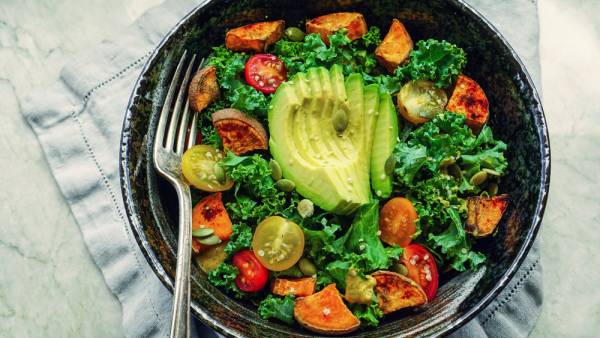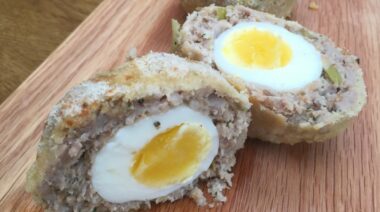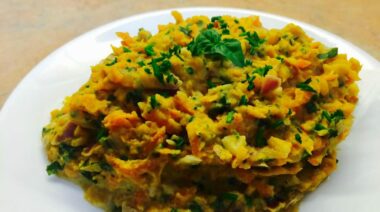When it comes to athletic performance and aesthetic endeavors like weight gain or lean muscle gain, a paleolithic template is not only doable, but preferable. Eating paleo isn’t just a weight-loss diet or fad. More than anything, paleo is about being healthy and fueling your body with balanced nutrition and the vitamins and minerals it was meant to consume. This can work in your favor if you want to gain weight, provided you know how to approach your eating plan. So let’s break it down.
Give Your Body What It Needs
I am not into counting calories, fat grams, or macros, nor do I believe you must in order to gain weight. Your body is already innately wired to know what it needs. Your body will tell you if it is or is not getting enough through symptoms like indigestion, satiety or hunger, weakness or fatigue, and strength losses.
But mindfulness about fueling your body is crucial. It all comes down to giving your body the three main macronutrients it needs on a daily basis:
- Protein
- Healthy fats
- Carbs (veggies, fruits, starches)
If healthy weight gain is your goal, then aim for the following ballpark amount of these macronutrients:
Protein: Eat protein with every meal, anywhere from 4-10 ounces. Exact amounts depend on your gender, current size, and digestion. This could amount to:
- 1lb of meat per day (grassfed beef/bison, organic chicken, pulled pork, etc.)
- 2-3 pasture-raised eggs or organic chicken sausage with breakfast
- 1-2 scoops of a quality sourced protein powder on a workout day
> Healthy Fats: >Fat is no longer a four-letter word. In fact, healthy fats promote better digestion and a revving metabolism. They decrease inflammation for better healing and recovery between workouts and help you maintain optimal brain function.
Reach for 1-2 servings with each meal to get a bigger bang for your daily intake buck. Fats are dense sources of energy, so one serving might look like:
- 1-2 Tbsp raw almond butter, coconut butter, or sunflower seed butter
- Half of an avocado
- A fistful of raw nuts/seeds
Other good sources include nitrate-free bacon, unsweetened shredded coconut, grass-fed butter, hemp or pumpkin seed oil, extra virgin olive oil, coconut oil, or avocado oil.
Carbs: Carb consumption makes a huge difference when it comes to putting on healthy weight via a paleolithic template. Starchy vegetables and a moderate intake of fruit are your best friends. Eat more sweet potatoes, potatoes, carrots, beets, squash, parsnips, pumpkin, and tubers, along with bananas, berries, apples, and other seasonal fruit.
At each meal, aim to include:
- A protein source (serving size: 1-2 palm sizes)
- 1-2 fats (serving size: spreads & oils=1-2 thumb sizes, fistful nuts/seeds, ½ avocado)
- And carbs (a starchier carb + veggies) with your main meals (serving size: this ebbs and flows, depending on rate of weight gain you desire)
Meal examples:
- Banana and raw almond butter with some turkey or chicken sausage and power greens
- Diced butternut squash in your morning egg, bison, and kale hash for breakfast
- A large Japanese sweet potato diced up in a hearty spinach salad, topped with chicken or tuna, avocado, roasted veggies, and some oil and vinegar
- A large Garnet sweet potato topped with coconut butter, grilled salmon, or flank steak, with a side of steamed broccoli
- 2-3 eggs overeasy with spinach and mushrooms, plus 2-3 slices nitrate-free bacon and half of an avocado
- 8oz grass-fed burger with a homemade roasted sweet potato or Idaho potato ‘fries’ drizzled with olive oil, sea salt, and pepper. Serve with sautéed greens.
- Smoothie recipe: 1 cup unsweetened almond/coconut milk + 1 serving quality protein powder + handful frozen berries or half a banana + 1-2 Tbsp raw almond butter, coconut oil, or coconut butter + heaping handful spinach
Get Comfortable With Carbs
Carb intake doesn’t have to be complex, but it is a crucial component of weight gain with paleo. It’s important to experiment and find what works for you. Here are a few tips for healthy carb intake:
- Remember Your Goals: Play around with the amount you consume to fit your goals and the rate of progress you want to see.
- Don’t Forget Starch: Incorporate a starchier carb source with each meal until you find you’ve reached your goal.
- Experiment With Grains: Some people (especially athletes) find they are able to tolerate some properly prepared grains, particularly before or after workouts. These include white rice, Basmati rice, steel-cut oats, and quinoa (pre-soaked to remove gut-irritating phytates prior to cooking). Stick to one grain source as one of your carbohydrates every day or every other day.
- Avoid Nutrient-Poor Grains: Continue to steer clear of pasta, flour, enriched breads, and other gluten-based products. A whole-foods approach is optimal for health, digestion, and lean muscle gains, as opposed to more fat gains.
- Don’t Forget Your Veggies: Veggies are unlimited carbs on any paleolithic template, regardless of your goals. They ensure you get in the host of vitamins and minerals you need for optimal health. Variety is the spice of life, and there is a rainbow of colors to choose from. Take a hint from Popeye and eat your greens, which will improve your power and recovery from workouts. Try any combination of kale, chard, spinach, collards, and power greens.

Snack Strategically
Weight gain philosophy typically suggests you should never be hungry. But that mentality can make eating feel like a chore – so much so that you begin to resent eating at times, primarily out of the discomfort of constantly being full.
While you should not go hungry, eating does not have to be like pulling teeth. Some people find they have more success by eating three larger meals each day, with 1-2 smaller snacks or protein shakes tossed in there. Others prefer to spread out their meals to a consistent 5-6 meals each day, eating a moderate portion at breakfast, lunch and dinner, coupled with some higher-calorie snacks between meals.
Here are some examples of high-calorie snacks to help you meet your weight goals:
- Handful of raw nuts/seeds
- Homemade trail mix (mixed nuts, dried fruit & coconut flakes—no added sugar) or Paleo granola
- Banana with almond butter or cashew butter
- Almond/coconut milk + protein powder
- Half an avocado or homemade avocado ‘pudding’
- Chicken or tuna salad made with primal/paleo mayo
- 1-2 spoonfuls of nut butter or coconut butter
- Leftover protein (can add some avocado on top)
- RXBar or Larabar
- Homemade nut/seed crackers with guacamole, Paleo hummus, nutbutter, grass-fed butter cubes, or grass-fed cheese
- Celery sticks with nut butter and raisins or dried cranberries
- Raw grass-fed cheese, yogurt, coconut yogurt, and possibly even raw, grass-fed milk (depending on your tolerance levels for dairy)
Focus on getting the majority of your intake at your main meals. Let snacks tide you over between meals if you find you have some room in your digestive system to take in a little bit more. Be strategic and find what works for you.
Don’t Dismiss Protein Powder
Protein powder is not paleo, strictly speaking. Cave people didn’t have tubs of powders back in their day. However, keeping an 80/20 balanced philosophy in mind (i.e. not ‘perfect’ paleo), protein powder can be a great addition to your weight gain efforts around your workouts.
Here are two ideal ways to use protein powder:
- Post-workout: Shake up 1-2 scoops in some water, coconut water (a great way to add more carbs in for the day), almond milk, or coconut milk to feed the machine with an easy source of instant calories for the body.
- In a smoothie: Protein powder is a good addition to your morning breakfast smoothie or snack smoothie, as liquid foods are more easily digested and can aid in preventing over-fullness during the weight gain efforts.
Look for brands without artificial sweeteners and the least ingredients possible. Experiment to find the right powder that cooperates with your body. It shouldn’t leave you running to the bathroom every time you drink it. Some varieties I like:
- Wild Whey by Wild Foods
- Collagen-Whey Protein blend by Natural Stacks
- Rebuild Whey by Revive-RX
- Bison-Egg protein by Paleo-Pro
Hemp protein powder is another good option. As for supplements, Natural Stacks has a BCAA line that is great for supporting muscle gains for your pre-workout routine. And you cannot go wrong with a quality fish oil or cod liver oil to support muscle building, metabolic function, and recovery. Otherwise, save your money on all those supplements that claim they are the golden ticket to success.
Listen to Your Stomach
A healthy gut is crucial to digesting all the nutrients and caloric load you are taking on during weight gain. If your digestion is impaired, then you will either not absorb the foods you are eating or feel miserable due to indigestion, bloating, or constipation. There are several measures you can take to better digest and absorb your food, despite the discomfort of fullness during weight gain. These include:
- Chew your food. Really chew it. You shouldn’t be able to recognize its original form before you swallow each bite.
- Drink lots of water throughout the day – at least half your bodyweight in ounces plus approximately 16-20 ounces around your workouts.
- Take a quality probiotic – 1-2 times per day.
- Consider digestive enzymes and HCL supplementation. Consult with a nutrition therapist, holistic practitioner, or another professional for guidance.
Break Through Walls
And, ultimately, believe. Regardless of your conceptions about paleo, the one tried-and-true fact is that it is, at its core, all about eating real food. By putting these pieces in place, you may find that, instead of running into that same old wall you have been hitting as a so-called hard-gainer, weight gain becomes easier and even enjoyable.
You’ll Also Enjoy:
- Top 10 Foods to Gain Muscle Mass
- A Paleo Primer: Benefits, Limitations, and Misconceptions
- For Skinny Young Guys: 3 Programs to Bulk You Up
- New on Pulse Beat Fit Right Now
Photos courtesy of Shutterstock.






